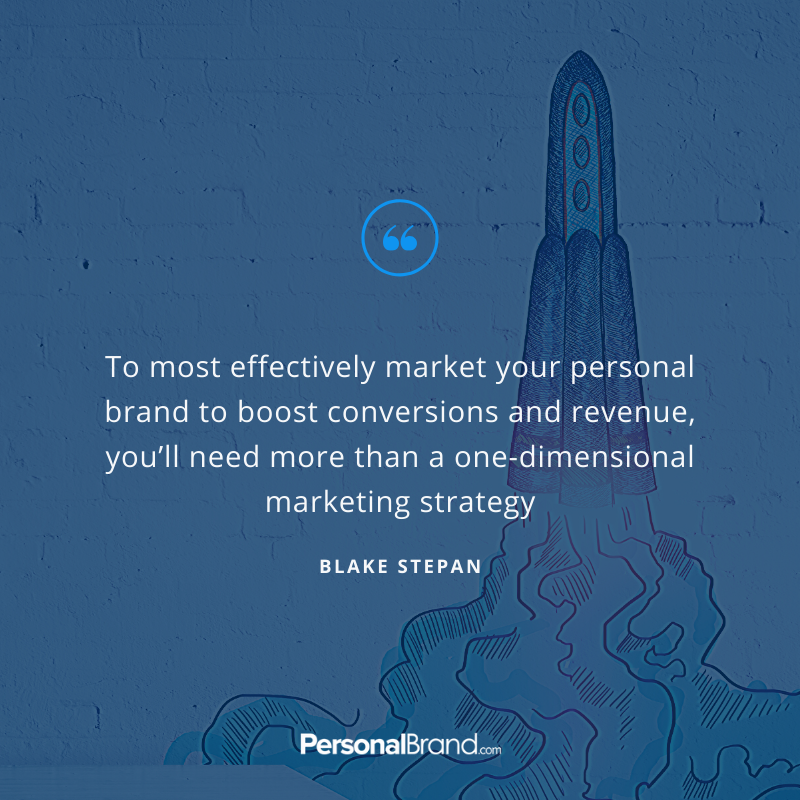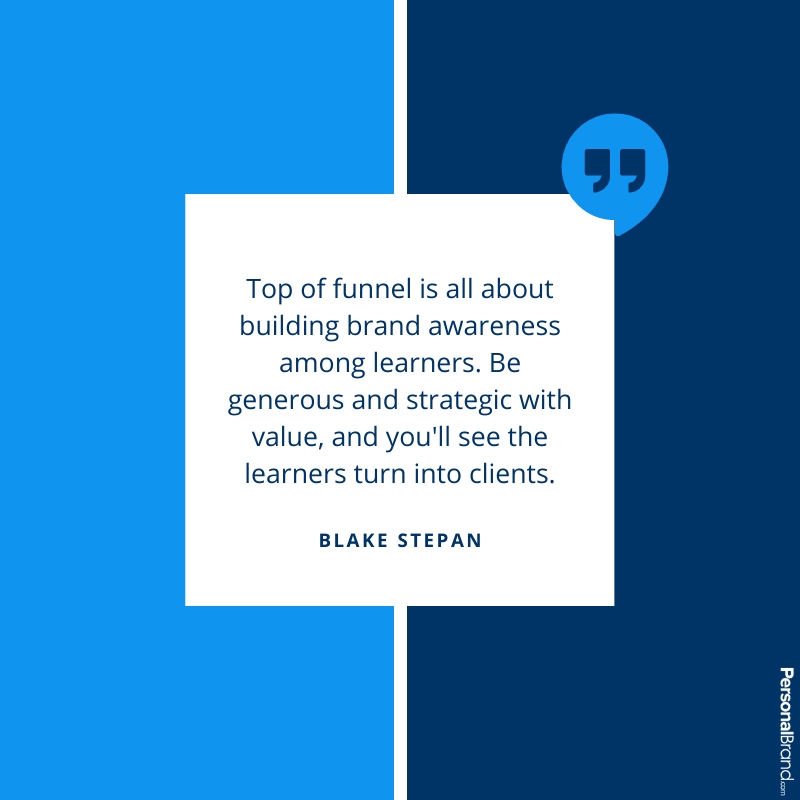The Marketing Funnel: What is it and How to Build One for Your Personal Brand
You’ve likely heard that marketing about reaching the right people at the right time with the right message.
Sounds simple, right?
You just need to find people who can use your product or service, reach them when they’re thinking about their needs, and pitch them with compelling messaging.
Unfortunately, marketing is not quite such a streamlined, lateral process, because not all your prospects are ready to buy at any given moment.
There are three phases that consumers traverse before they purchase any product or service: learner, shopper, buyer.
Marketers use the framework of the marketing funnel to understand the needs of their prospects in each of these phases and construct impactful marketing messages via relevant channels to move people along the marketing continuum—or down the funnel, from learner to a shopper, to buyer.
To most effectively market your personal brand to boost conversions and revenue, you’ll need more than a one-dimensional marketing strategy.
You’ll need to understand the fundamentals of the marketing funnel, the mindset of prospects within its free phases, and how you can effectively market to them throughout their buying journey until they go from stranger to raving fan.
What is the Marketing Funnel?
Marketing fundamentals are rooted in the same psychological behaviors that have driven purchasing decisions for over 100 years.
The marketing funnel that still stands today as a cornerstone in business management and marketing education was created by E. St. Elmo Lewis, in 1898. Lewis’ marketing funnel is still relevant, despite how much technology and media have changed in the past 120 plus years.
Experts and educators often depict the marketing funnel as an inverted pyramid, vertically segmented as follows:
- Awareness
- Interest
- Desire
- Action
Marketers often strategize how they reach and speak to prospects based on where they are in the lead nurturing process, or where they are in the marketing funnel. The funnel is therefore often segmented into:
- Top of Funnel, or TOFU
- Middle of Funnel, or MOFU
- Bottom of Funnel, or BOFU
Let’s Dive Deep into Each Segment
TOFU – Someone Needs Help
At the top of the funnel, you have your learners—people who are becoming aware that they have a need and begin researching available options to fulfill it. At this phase, your prospects are starting to educate themselves about products and services in your category. Such choices will include you, your direct competitors, and your indirect competitors.
Take someone, for example—let’s call her Jane Smith—who earns a promotion and finds herself in a role where she will need to give regular presentations in front of large audiences. As someone who has always been terrified of public speaking, she realizes that she needs to improve her public speaking confidence, preparation, and delivery, and begins the process of learning about options that may help.
Jane Smith begins her search with Google and asks for advice from friends and colleagues. She learns that her available solutions include books on public speaking, training courses, and one-on-one coaches.
MOFU – Analyzing Options
The middle of the funnel is where prospects choose which solution path to take and begin to compare competitive service providers.
Let’s go back to Jane Smith. Armed with the knowledge of available pathways to reaching her goal, Jane Smith narrows her focus. She’s decided that she doesn’t have much time to improve on her own. Jane Smith wants one-on-one guidance and training. Jane begins shopping for a coach. She refers to the information she found previously on public speaking coaches in her area and adds to her selection set with more Google searching and referral seeking.
BOFU – Let’s Make a Deal
The bottom of your marketing funnel is the narrow end of the inverted pyramid. This is your small but valuable segment of prospects who are ready to make a purchase. In this phase, you want to give potential buyers a compelling reason to buy from you by proving your value, offering products and services that address their needs, and making it easy to complete a purchase.
Let’s see how Jane Smith’s journey ends.
Jane Smith is ready to improve her public speaking. She’s found a reputable, proven coach within her area and budget, who can deliver the results she needs on her timeline.
She’s successfully moved from a learner—someone aware of a need, to a shopper—someone who assesses her options—to a buyer.
Now, let’s look at Jane Smith’s journey from the position of the coach who won her business.
TOFU – Category and Brand Awareness
When Jane Smith first began searching for solutions to her problem, she went to Google. Upon searching for “public speaking help,” she found paid search ads for “John Doe Public Speaking Coach.” Further legitimizing that business, John Doe’s website appeared among the top three organic search results on Google.
When Jane Smith asked colleagues for advice, a contact in a LinkedIn group suggested a personal public speaking coach and provided a raving review of his past work with John Doe.
MOFU – Thought-Leader Positioning
Having researched a variety of public speaking improvement options and deciding on a personal public speaking coach, Jane Smith needs to shop for the one that will best suit her needs and fit her timeline and budget. John Doe was one of five experts whom Jane Smith came across in her learner research, so she digs into each personal brand, reviewing their websites, reading some of their blog articles, and following their social media content.
Jane Smith is impressed with the methodology that John Doe summarizes on his website. Where some of the other public speaking trainers and coaches promise results without specifying how they will get there or proving past results, John Doe’s homepage summarizes an understandable, achievable three-step process.
Further proving the success of John Doe’s methodology, his website includes case studies, testimonials, and before and after videos from highly satisfied clients. John Doe has written dozens of blogs that breakdown some of the common issues related to poor public speaking performance.
These include inefficient preparation, fear, and disorganization, and provides some high-level guidance for overcoming those issues.
On his YouTube channel, John Doe offers a five-part, hour-long series that talks about preparing for a public speaking session.
What sells Jane Smith on John Doe as the best choice for her needs, is John Doe’s backstory. On his bio page, John describes having to give sales presentations in his previous careers as an advertising executive. He even shares a video of himself awkwardly and unconfidently fumbling through a presentation.
John Doe talks about how his ineptitude ultimately resulted in him losing his job, and then resolving to solve his public speaking problem and help others to do the same. Jane feels that John Doe will empathize and understand her needs.
Jane Smith further learns that John Doe maintains a million-dollar business, is one of the most sought-after public speaking trainers for executives, and has a portfolio of C-suite level clients from large organizations who consider him a mentor and friend.
Jane Smith is ready to buy from John Doe.
BOFU – Choosing a Solution
Now that Jane Smith knows she wants public speaking coaching from John Doe, she needs to decide which of his offerings will fit her needs. John Doe offers a variety of product and service options, including:
- A self-guided podcast series and accompanying workbook
- A three-day workshop available next month at a nearby city
- A three-month personalized coaching plan that begins with a free hour-long consultation
Given Jane Smith’s timeline and budget, she chooses the individualized coaching plan. She clicks the purchase button, and Jane Smith has completed her journey from a learner to a shopper to a buyer.
What’s important to observe in this hypothetical situation are all the various marketing channels and content types that John Doe leveraged to reach Jane Smith at each phase of her customer journey:
- TOFU Phase: A search engine optimized website and awareness building, paid search advertising campaign.
- MOFU Phase: A content marketing strategy that leverages social media, thought leader content, and educational articles to position John Doe as a credible, proven, authority in the public speaking coaching space.
- BOFU Phase: A variety of product and service solutions to fit diverse customer needs, and a website that ensures prospects can clearly assess available options to find the solution they need, and then complete an online purchase transaction.
Now that we’ve experienced both the customer and personal brand journey through the marketing funnel, let’s talk about how you can build a marketing funnel for your personal brand.
How to Build a Marketing Funnel for Your Personal Brand
Your TOFU goal is all about building brand awareness among learners.
To be successful, you’ll need a strong brand, a clear message, a multi-channel communication strategy, advertising, public relations, and relationships with industry leaders and influencers.
Let’s talk about the strategies and tactics you’ll need to focus on to build each phase of your marketing funnel.
TOFU: Brand Awareness
Top of the funnel prospects need to learn about your personal brand and your methodology. Focus on a blend of brand awareness marketing efforts for your TOFU prospects, including those that follow.
Search Engine Optimization (SEO)
While you don’t necessarily need a website to build a personal brand, you will need a landing page where learners can gain more knowledge about you and your offering, such as a Facebook page. In this phase, SEO is critical. You’ll want to understand the keywords and phrases that prospects search for when in need of your services.
Going back to our public speaking personal brand example, John Doe must include a variety of words and phrases that may come to mind for learners looking to improve their public speaking. Their search phrases may not always be as straightforward as “public speaking coaches.”
They may encompass a wider net of inquiries (e.g., public speaking coach, public speaking expert, public speaking trainer, public speaking training, public speaking solutions, how to improve my public speaking), and John Doe may leverage both paid and organic search strategies to reach them all.
Paid Advertising
Paid search ads, paid social media ads, and even traditional advertising in relevant industry publications, will help to introduce more prospects to your personal brand. It is not enough to simply create ads, however.
You will need to create ads with clear, succinct, and impactful messaging that resonates with prospects in the TOFU phase of their journey, and that direct them to additional content to learn more.
Depending on the ads’ placement and message, you may want to direct them to your website, a social media page, or a product or event landing page.
MOFU: Content Marketing
Your middle of the funnel content marketing strategy is not about you, your brand, or your products or services. It’s about educating your prospects and proving yourself as a thought leader.
In the middle of the funnel phase, leverage a variety of communication channels and form factors to create a content marketing strategy to educate your audience on your differentiators and further position yourself as a thought leader in your space.
Content Marketing
Begin your focus on developing broad educational topics related to your area of expertise, such as:
- Informative blogs
- How-to videos
- Instructional guides
- Checklists and assessments
- Inspiring social media content
- Interview marketing or podcasts
- Infographics
Email Marketing
For prospects in the nurture phase, email marketing is a valuable tool to keep your brand’s conversation with them progressing. By allowing shoppers to sign up for a newsletter, an email nurture sequence, or an educational email series, your personal brand can remain top-of-mind while you continue to showcase your credibility and authority.
Public Relations and Earned Media
PR is all about legitimizing your thought leader status by leveraging relationships with respected third-party media outlets. A combination of press releases and articles published by reputable media sources in your industry, and earned media—content you’ve authored that appears on third-party news sites—will best frame your status as a trustworthy and knowledgeable resource.
Webinars
Webinars are sources of valuable, engaging content that help showcase your knowledge and expertise on a specific topic in a way that teases prospects to want to learn more—in the form of paid products and services.
BOFU: Conversion Content
When prospects reach the bottom of your marketing funnel, you need to give them compelling reasons to make a purchase and make it easy to buy.
Product and Service Content
Your website or landing page must be architected to make it easy for prospects to learn about your available products and services, obtain answers to their questions, and make a purchase, ideally directly from your website using a reliable conversion form.
Credibility Content
Before a prospect gives up his credit card, he wants to feel confident that he’ll experience a positive ROI. Showcase your credibility and demonstrate proven results using case studies (in print and video format), testimonials, and referenceable client or brand customers.
Getting Started Building Your Personal Brand Marketing Funnel
If all of this feels overwhelming, start at the top of the funnel, and work your way down.
Begin by ideating your brand’s value proposition, creating a compelling top of the funnel message, and creating brand awareness.
Then, focus on creating a steady cadence of educational content to intrigue and educate your prospects as they move through your funnel.
Finally, add testimonials and case studies to your website as you earn success stores.
Further, strengthen your offering for your bottom of the funnel prospects by developing your catalog of products and services. Create a compelling cross-sell and upsell strategy.
Remember that a marketing funnel is all about nurturing prospects and building a relationship with them.
Use your marketing funnel to get to know potential clients while they get to know you. Assess what works and where you could strengthen your strategy. Pivot, test, iterate, and test again. As your marketing funnel evolves, your personal brand’s power will increase—and so will your revenue.
If you’d like to learn more about creating marketing funnels and developing your company’s engine, click here to sign up for our Income + Impact Accelerator course today.


Take It One Step Further
A personal brand is the best way to increase your impact, influence and income. Start building your personal brand today, we’re here to help!
For more, great content on how to build your personal brand, subscribe to our newsletter and join our private Personal Brand Builders community. You’ll never have worry about missing our latest and greatest tips, strategies, and advice for building your personal brand.
We hope you enjoyed this article. Follow us on Facebook, and Twitter for updates every time we publish!


